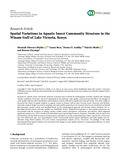| dc.contributor.author | Misiko, Monicah Florence | |
| dc.contributor.author | Bere, Taurai | |
| dc.contributor.author | Andika, Darius O. | |
| dc.contributor.author | Okoth, Patrick | |
| dc.contributor.author | Onyango, Benson | |
| dc.date.accessioned | 2023-09-12T12:06:06Z | |
| dc.date.available | 2023-09-12T12:06:06Z | |
| dc.date.issued | 2023-09-08 | |
| dc.identifier.uri | https://www.hindawi.com/journals/ijecol/2023/8817525/ | |
| dc.identifier.uri | https://doi.org/10.1155/2023/8817525 | |
| dc.identifier.uri | http://ir-library.mmust.ac.ke:8080/xmlui/handle/123456789/2273 | |
| dc.description.abstract | Background. Aquatic insect community structure is dynamic due to threats by anthropogenic activities coupled with changing climatic conditions. The insect’s survival is dependent on the substrate, water quality, and environmental effects. The changes in water quality influence their distribution and abundance and are reflected in spatial and temporal trends. This study sought to document the effects of spatial variation on aquatic insects in Winam Gulf of Lake Victoria, Kenya. Materials and Methods. Systematic random design was used in sampling, and water quality parameters were assessed. Insects were sampled by profundal lake procedure, pooled, sorted, and identified based on the morphological approach and diversity indices analyzed. The relationship between insects and water quality was established. Results. Statistical homogeneity in water quality parameters was documented with the exception of nitrates, nitrites, soluble reactive phosphorus, ammonium, and silicates, which displayed significant variation at . A total of 383 individual insects representing 19 species, 19 genera, 16 families, and six orders were obtained from Winam Gulf. Hemiptera, Ephemeroptera, and Diptera were the most predominant orders, respectively. Chironomus spp. and Ablebesmyia spp. were representatives of the Chironomidae family. Species distribution and water quality were determined using cluster analysis (CA) and conical correspondence analysis (CCA). Conclusion. The findings of this study demonstrated that spatial variations were associated with change in water quality and had a corresponding influence on insect community structure. | en_US |
| dc.language.iso | en | en_US |
| dc.publisher | International Journal of Ecology | en_US |
| dc.subject | Spatial, Variations, Aquatic, Insect, Community, Structure, Winam, Gulf, Lake, Victoria | en_US |
| dc.title | Spatial Variations in Aquatic Insect Community Structure in the Winam Gulf of Lake Victoria, Kenya | en_US |
| dc.type | Article | en_US |

